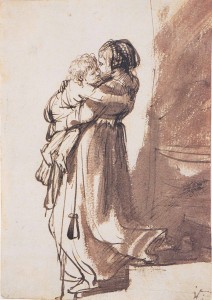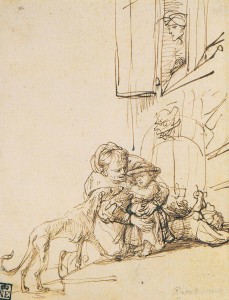When I was younger I thought that big ideas could only be found in big works —symphonies, operas, murals, large paintings, and so on. Foolish, of course, but in those days I was much enamored of ‘grand’ things. With time and age I came to realize that, while my former notion wasn’t entirely incorrect, often the purest expression of an artist’s spirit comes in small scale work. It allows for an intimacy that grander offerings can’t provide.
No one would seriously dispute the greatness and humanity of Rembrandt’s painting, but I think the human being that was the artist is most truly present in his sketches and casual drawings. And sketch he did. Every imaginable subject came within his sights. He particularly liked to capture the simple goings on of his household. Indeed, he was a man who needed a household and a steady female companion. In 1634 he married Saskia Uylenburgh, who was the great love of his life. She bore him four children, though only one, his son Titus, survived infancy. Sadly, Saskia herself died young in 1642, living only one year after the birth of Titus. Rembrandt soon transferred his affections to Titus’s nurse, Geertje Dircx, before, in 1649, entering into a common-law marriage with Hendrickje Stoffels. And through it all he was drawing. We see Saskia going about her daily tasks, combing her hair, sleeping. His drawings of Saskia on her sick bed are heartrending. His loss was terrible but the drawing goes on. We see Geertje rearing the young Titus, teaching him to walk, easing him past his fears.
Rembrandt’s fascination with observing and interpreting everyday life never slackened. Nothing was too small or simple for his pen—cooking, cleaning, bathing, child rearing, eating, even peeing along a roadside. Whatever the members of his household or the people in the neighborhood were doing found a place in his sketchbook, and nowhere else does his fundamental sympathy with the human condition come through as clearly. He gave us many drawings focused on motherhood and they are personal, honest, real —so very different from the sentimentality of the Victorians.
Draftsmanship of this caliber has rarely been equaled; it has never been surpassed. Notice that in Women Teaching a Child to Walk the women are only represented by a few lines, but these are all the viewer needs to feel the tenderness and care the women have for the child. In Child Frightened by a Dog, the emotions of all those present —the woman, the child, and the dog— are all perfectly captured. And finally, in Naughty Child, one feels the frantic tantrum of the child and the struggle of the woman, her body tensed, her weight pressing on her front leg, her upper body rigid as she struggles to deal with the child’s manic energy. I confess that this happens to be one of my favorite drawings in all of art.
So here’s wishing a Happy Mother’s Day to mothers everywhere, past, present, and future. Rembrandt van Rijn has given expression to your patience, energy, and endurance as you bring the next generation along.
Return to Artists and Their Art
Copyright 2013 James Tucker



